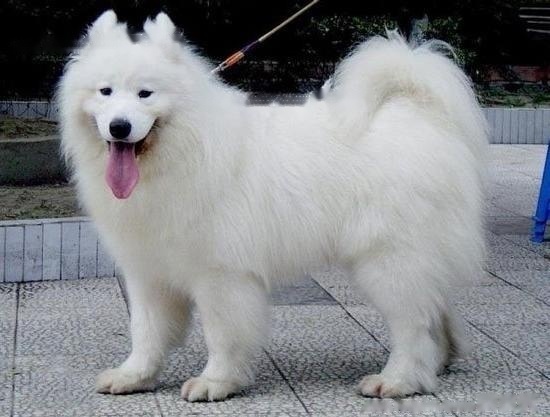Samoyed (Samoyed), alias Samoyed, was originally a dog breed bred by the indigenous Samoyed people in Siberia. Alert, strong, flexible, beautiful, noble and elegant, well-behaved and cute, with a very striking appearance, strong physique, and the title of smiling angel, naughty and agile before the age of one. Male dogs 53.3-59.7 cm, female dogs 48.3-53.3 cm.

Head
The cranial and muzzle are proportional to the body shape and size of the skull and are slightly triangular. The muzzle must have a certain thickness. The beard must never be cut off.
Ears strong and thick; erect; triangular with slightly rounded tips. The size of the ears is based on the size and overall size of the head. The distance is relatively wide, close to the outer edge of the head, and appears flexible; covered with many hairs, the hair is full. The ears are well mobile,
hairs grow on the inside of the ears, and the hairs in front of the ears are profuse and erect. The length of the ear should be the same as the distance from the inside of the ear to the outer corner of the eye.
The eyes should be darker in color, set apart and deep; almond-shaped; the lower eyelid points to the base of the ear. Dark circles are ideal. Round eyes or bulging eyes are a defect; blue eyes are a disqualification. Black nose is ideal, but brown, liver, and charcoal are acceptable. Sometimes the color of the nosepiece changes with age and climate. Teeth strong, straight, strong, scissors bite. The upper and lower jaws should not be too prominent. The lips are preferably black and sensual, and the corners of the mouth are turned up like a smile. The lips at the corners of the mouth should not sag.
Body
The neck is strong, the Samoyed is well muscled, proudly held up, looking full of power, supported on sloping shoulders when standing at attention with a noble head. The neck joins the shoulders to form a graceful arch. The chest is deep, and the ribs expand outward from the spine, flattening out to the sides, without impairing shoulder movement and allowing free movement of the front limbs of the Samoyed. Not a barrel chest. The ideal depth should reach the elbows, and the deepest part should be behind the forelegs, about the level of the ninth rib. A chest deep enough to protect the heart and lungs within the chest cavity is more deep than wide.
The loin and withers are the highest point of the back and the loin is strong and slightly arched. The back is straight (from withers to loin) and of medium length. The proportions of its body are nearly square, i.e. about 5% longer in length than in height. Females may be longer than males. The abdominal muscles are tight and well-shaped, forming a graceful curve with the back of the chest (abdomen). The rump is slightly sloping, full and must extend to a very slight base of the tail.
The tail is of moderate length, and if the tail is drooping, the length of the coccyx should extend to the hocks. The tail is covered with long hair, rolled over the back when alert, or rolled to the side, and lowered when resting, in the presence of a Samoyed. The root of the tail should not be too high or too low, and the tail should be flexible. Having two curled tails is a defect. The condition where the tail is turned up higher than the back can only occur once during the competition.
The forelegs are parallel, straight and strong. The forelimbs are longer because of the deep chest. The height from the ground to the elbow is about 55% of the height from the ground to the upper edge of the shoulder blade. Dogs with short limbs do not meet the standard. Shoulders should be long and sloping at an angle of about 43°, with strong shoulders. The distance between the upper edges of the shoulders and feet is approximately 2.5-3.8 cm (1-1.5 inches). The thighs are well developed, the knee joint is about 45 degrees to the ground, and the hock joint is at the lower 1/3 of the shoulder height.
Viewed from behind, the dog's hind legs are parallel when standing naturally. Straight or bull-like knees do not meet the criteria. Whether the knee joint is bovine can only be determined when the dog is fully exercised. Dogs with short limbs do not meet the standard. Strong shoulders. The distance between the upper edges of the two scapulae is about 2.5 to 3.8 cm (1-1.5 inches). The feet are large, long, and relatively flat, like those of a hare, with slightly separated toes; the toes are arched, the pads are thick and hard, and there are protective hairs between the toes. In the natural standing state, the feet are neither abducted nor turned inward, but vertical, but when pulling the cart, the feet can be turned slightly inward. Feet abducted, dove-like toes, rounded or cat-like feet; excessively separated toes are faults. The hair on the feet is not necessary, more bitches than males.
![[Dog Training 5] The training method of pet dog dining etiquette](/static/img/12192/12192_1.jpg)




